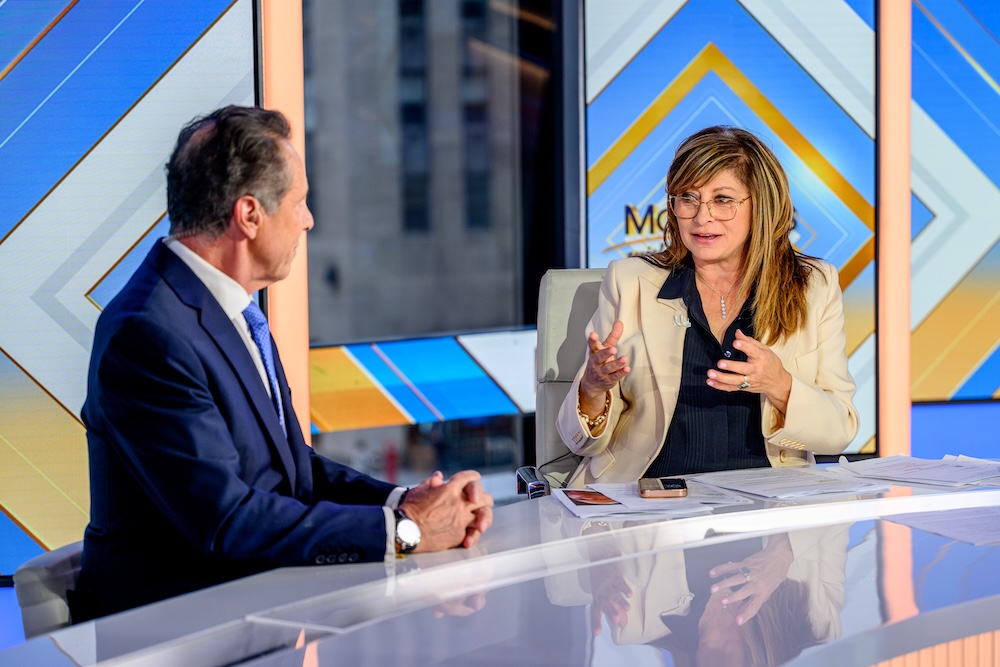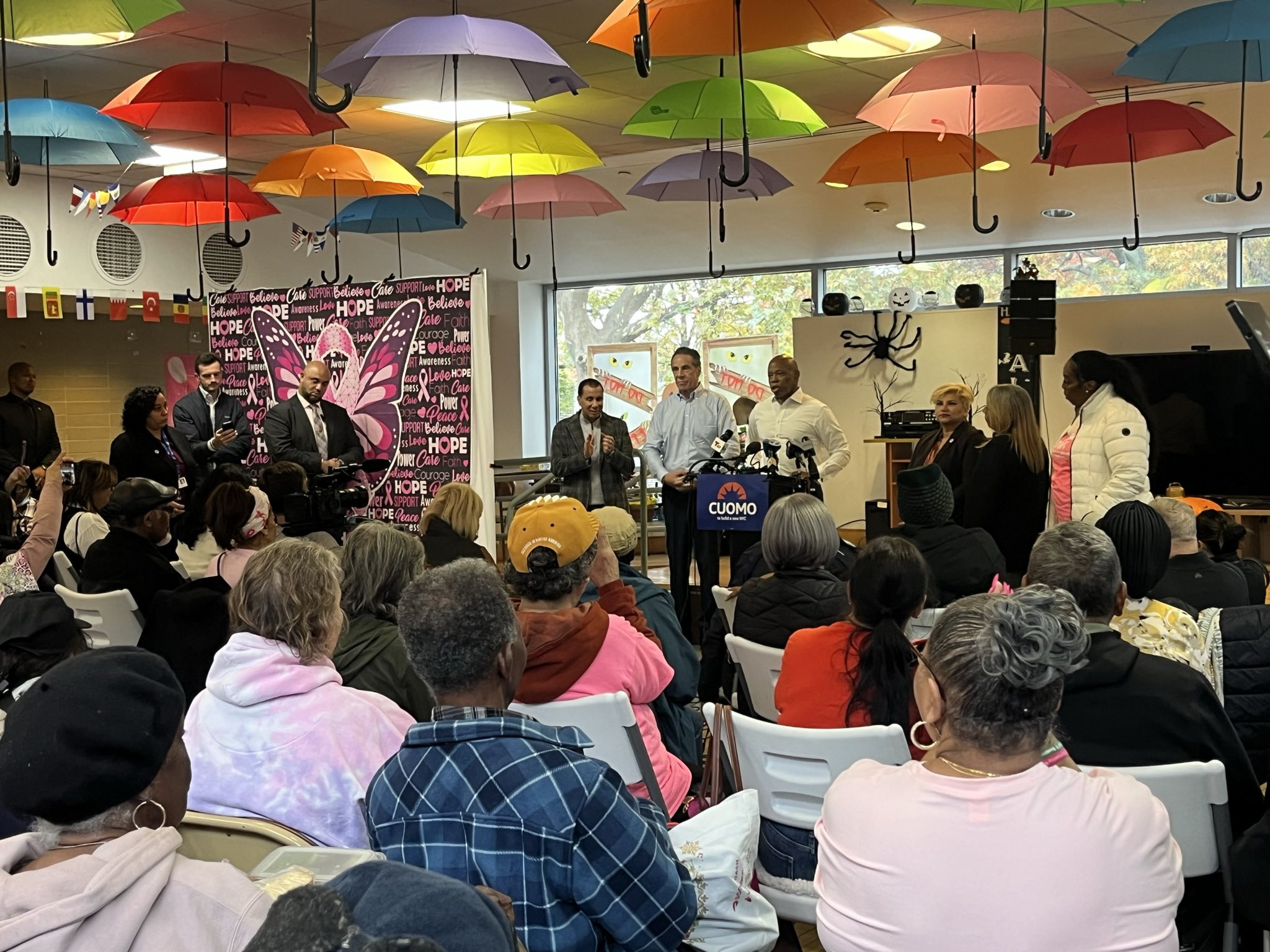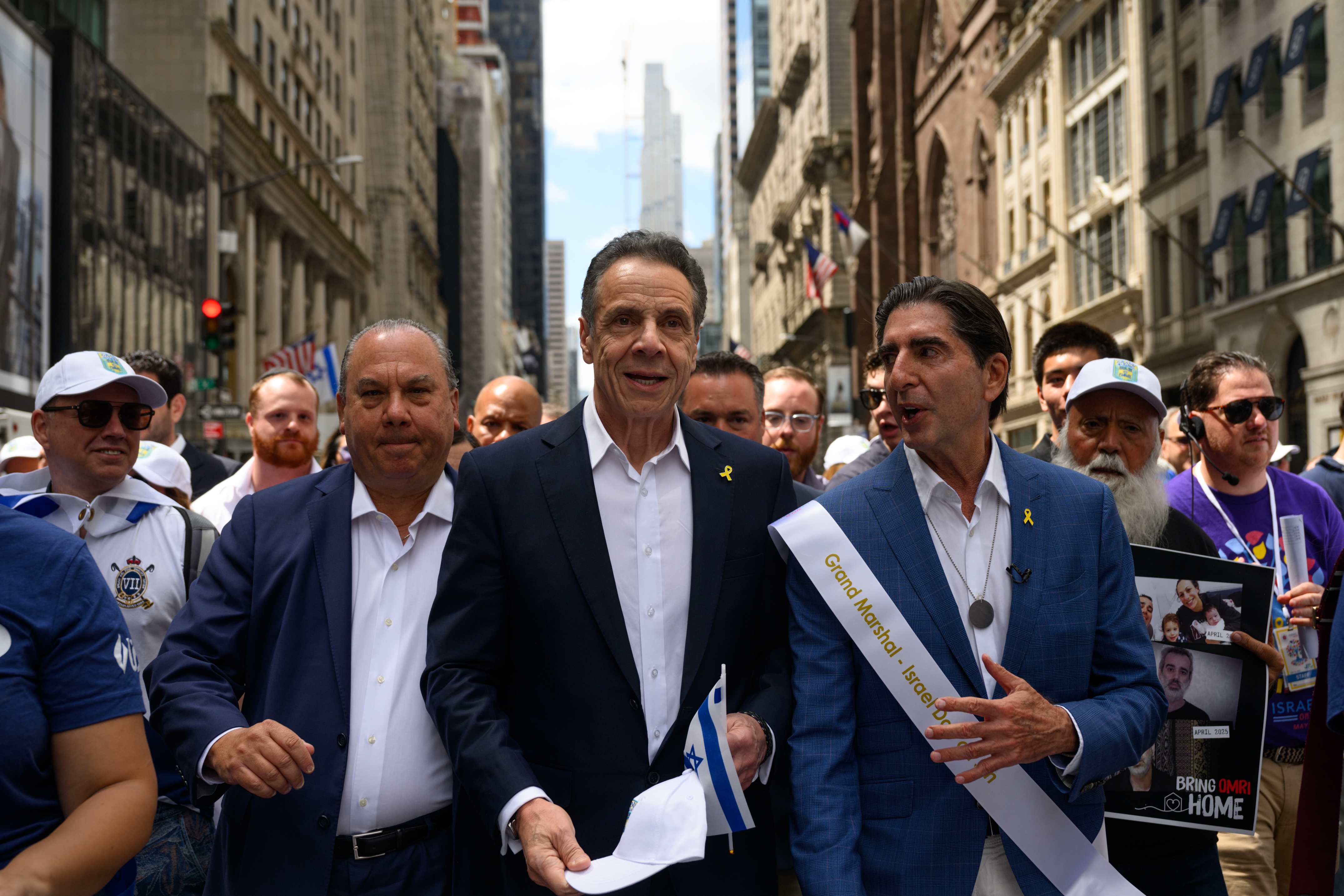2025 New York City Mayoral Election
The unlikely coalition Andrew Cuomo is trying to build
There’s no doubt he’s the underdog. But if this unusual combination of voters shows up for him, he’s got a chance.

Mayoral candidate Andrew Cuomo made a stop on Staten Island Wednesday, standing with Italian Americans to criticize Mamdani’s views on Christopher Columbus. Spencer Platt/Getty Images
Early voting kicked off with a bang, not a whimper in New York City with nearly 300,000 voters hitting the polls across the first four days to cast their ballots in the mayoral race.
With little data available at this stage and a week to go until Election Day, drawing conclusions from the numbers is a bit like reading tea leaves: limited and easily twisted to fit an agenda. Older voters do appear to have led the charge so far, according to an analysis from Gothamist that found New Yorkers over 55 made up slightly more than 51% of turnout in the first four days of early voting. The largest single share of the vote came from voters 65 to 74. That's a significant shift from the Democratic primary where younger voters dominated early voting.
Cuomo’s camp has taken the engagement as a promising sign, pointing to his support with older New Yorkers. Still, the former governor is in a very different position than the one he was in as a candidate in the June primary. In just a few months, he’s gone from dominating front-runner to underdog – polling second to Democratic nominee Zohran Mamdani. To have a shot against the 34-year-old Democratic socialist in the general election as an independent candidate, he’ll need to go well beyond the coalition he assembled in the Democratic primary.
“We’ve seen this movie before – in the Bloomberg and Giuliani races, late polls missed the surge of real, working-class voters who turn out when it counts,” Cuomo spokesperson Rich Azzopardi said in a statement, referencing the latest poll from Quinnipiac University that found Mamdani leading with 43% and Cuomo in second with 33%. “The same thing is happening now.”
Mamdani achieved his historic victory in the Democratic primary with unprecedented support, uniting and activating young voters across racial and cultural lines, progressives, South Asian and Muslims, rent-stabilized tenants and beyond. As the Democratic nominee, he’s positioned to build an even bigger tent heading into the general election.
Cuomo meanwhile is trying to cobble together his own unprecedented coalition. As an independent candidate in a city where registered Democrats outnumber Republicans 6 to 1, he’s still banking on support he had in the Democratic primary: older New Yorkers, homeowners, and Black and Jewish voters. But he’s also trying to consolidate the anti-Mamdani vote, peel Republican voters away from Republican nominee Curtis Sliwa and win independent voters – while also making gains with some of the very groups that overwhelmingly went for Mamdani in the primary. Here’s a breakdown of the demographics he’s targeting.

Republicans and conservative independents
Cuomo is seeking the support of Republicans and more conservative independent voters – a complex task for one of the state’s most well-known Democrats. Over the past few weeks, he’s repeatedly appeared on Fox News and conservative radio programs, he’s campaigned in Republican stronghold Staten Island several times, and he was a guest on influencer Logan Paul’s podcast. His strategy across these platforms has been two-pronged: slam Mamdani and elevate issues that appeal to more moderate and conservative voters like hiring 5,000 new police officers and expanding gifted-and-talented programs in public schools.
“I don’t have horns,” Cuomo joked while appearing on conservative radio host Sid Rosenberg’s show last week. “I need your voters to vote for me.”
It’s a delicate balance – courting Republicans and more conservative independents without alienating Democratic voters. Cuomo is walking another tightrope when it comes to President Donald Trump, striving to convince voters that he is well-equipped to stand up to the White House without turning off New Yorkers who voted for the president.
Republican nominee Curtis Sliwa, who is polling in third, is doing Cuomo no favors either. He’s refused to drop out of the race and thrown barbs at the former governor both on and off the debate stage. Cuomo is attempting to peel supporters away from Sliwa, arguing that he’s not a viable candidate and that a vote for the Guardian Angels founder amounts to a vote for Mamdani. Many Republican electeds like Rep. Elise Stefanik, a handful of City Council members and all five county party organizations have been unmoved. But some like billionaire John Catsimatidis, Rep. Mike Lawler and Republican City Council Member Inna Vernikov have reluctantly endorsed Cuomo.
“(Cuomo’s) got a better shot of getting independents than he does more conservative voters because they’ll wind up with Curtis,” Democratic political strategist Hank Sheinkopf said. “Only Curtis can undo that block if he were to say ‘I need you to save New York and vote for Andrew no matter how you feel’ that would be a lot more helpful.”

Older New Yorkers
Cuomo, who is 67, was royalty in the Democratic Party for decades. That doesn’t just go away. He dominated in the primary with Gen-Xers and baby boomers, groups that have cast votes for Cuomo and his father Mario Cuomo for decades. This cut across demographics and income brackets. These generations participate in local elections at disproportionately high levels and tend not to be as bothered as younger voters by Cuomo’s scandals – such as the sexual harassment allegations that led to his resignation as governor in 2021 or his management of the COVID-19 pandemic. Cuomo’s breadth of executive experience is something he’s frequently invoked as a mayoral candidate, drawing a sharp contrast between himself and the younger, less experienced Mamdani.
As far as polling goes, Cuomo’s numbers with older New Yorkers aren’t quite as dominating as they were throughout the primary, though he is still largely ahead. The most recent poll from Quinnipiac University found that 41% of 50 to 64 year olds back Cuomo to Mamdani’s 35% and 39% of voters 65 and older support Cuomo to Mamdani’s 33%.
Older Black voters, one of the city’s most reliable voter groups, strongly favored Cuomo in the primary, but didn’t turn up in the same degree as they did when Mayor Eric Adams was first elected in 2021. Having dropped out of the race last month, the mayor has begun campaigning with Cuomo in neighborhoods where he remains popular in hopes of driving up turnout for the former governor. While Black New Yorkers have long been loyal, down-the-ballot Democratic voters in New York City elections, Democratic political strategist Lupe Todd-Medina said that Cuomo is far from your typical independent candidate. He’s got near universal name recognition – and lingering good will from his father’s tenure leading the state. “Grandma might not even be voting necessarily Andrew Cuomo, she’s voting Mario Cuomo – she’s voting the name,” Todd-Medina said.
Today I had the honor of visiting the Darul Hidaya Mosque in Jackson Heights— thank you for your support & friendship: I won’t let you down pic.twitter.com/7vPo7nKjvm
— Andrew Cuomo (@andrewcuomo) October 3, 2025
Muslim, Hindu, South Asian and East Asian communities
In recent weeks, Cuomo has significantly stepped up his efforts to court moderate and conservative Muslim, Hindu and South Asian voters after these communities turned out in droves for Mamdani, reshaping the electorate. Mamdani is Muslim and was born in Uganda to Indian parents. Since struggling to recall the last time he’d visited a mosque during one of the primary debates, Cuomo has campaigned at multiple mosques. On Oct. 19, he launched a multi-denominational group called “South Asians for Cuomo” (though his initial social media post about the event mislabeled the community as Southeast Asians, a very different regional identity). He’s visited a number of Hindu temples and attended the launch of a group called “Hindus for Cuomo” in September.
While the recognition has been appreciated by some, Cuomo’s efforts have also been controversial. He’s questioned Mamdani’s own Muslim bonafides, arguing that the Democratic nominee’s support for the decriminalization of prostitution is antithetical to the faith. (Mamdani has supported legislation in the Assembly tied to this, but has made no mention of the issue on the campaign trail.) A video recently released by Cuomo’s campaign featuring four people declaring themselves “Muslims Against Mamdani” includes similar claims. The attacks have drawn criticism that Cuomo is exploiting longstanding sectarian divisions between Shia and Sunni Muslims. At the same time, Cuomo’s campaign has also drawn criticism for leaning into Islamophobia. He’s also been accused of playing into attacks on Mamdani from the Hindu right-wing ecosystem, pitting Indian New Yorkers of varying faiths against each other. Mamdani has a history of criticizing Indian Prime Minister Narendra Modi and his far-right Hindu nationalism, citing his treatment of Muslims.
“Despite his campaign demonstrating no credible interest in, or understanding of, New York City’s diversity, Cuomo has nonetheless identified the Hindutva-fueled sharp-right turn amongst many Indian Hindus,” said Democratic strategist Amit Singh Bagga, who is Hindu and Sikh. “But instead of recognizing that and deciding to play a role where he attempts to unify the communities, he is exploiting fear and hatred to create further division.”
Cuomo has also ramped up his outreach to East Asian voters, a population that has been drifting to the right in New York City for years. While Mamdani has pledged to eliminate gifted and talented programs in public schools for the city’s youngest students, Cuomo joined an Asian American political club to announce he plans to expand them instead. He’s also said he would no longer replace Rikers Island with four borough-based jails – including the highly unpopular Manhattan location planned for Chinatown – and build new detention facilities on the island instead.

Jewish New Yorkers
Cuomo has made fighting antisemitism a central issue throughout his primary and general election campaign. He’s pitched himself to Jewish voters as a stalwart supporter of Israel and argued that Mamdani is a distinct threat to the community – even accusing him of stoking “flames of hatred against Jewish people.” Seeking to shore up one of his strongest areas of support as early voting kicked off, Cuomo rallied with hundreds of Jewish New Yorkers in Queens last weekend.
Mamdani’s support for Palestinian rights and criticism of Israel for its war in Gaza has divided the city’s diverse Jewish community. Of course, Jewish New Yorkers are not a monolith by any means – one recent poll from Fox News found that about 42% of Jewish voters support Cuomo and 38% support Mamdani. Many supported him in the Democratic primary and will do so again in the general election. But this has been one of the biggest areas of opportunity for Cuomo – particularly with Orthodox Jews despite clashing with these communities over his COVID-19 restrictions as governor during the pandemic. (Cuomo apologized for this in a recent video.) In the Democratic primary, he’d gotten support from all the major Hasidic sects and large Jewish voting organizations. Some have voted to endorse him again in the general.
We had an extremely packed house (500+ RSVPs) for tonight’s “Cool Girls for Capitalism” event in support of Cuomo for mayor. The whole event came together in less than 1 week
— erica wenger️ (@erica_wenger) October 28, 2025
I don’t support antisemitism or socialism so that makes my vote easy! Save NYC! pic.twitter.com/q4Hm2j4RQb
The wealthiest New Yorkers
Mamdani won more of New York City’s richest neighborhoods in the Democratic primary, but his affiliation as a Democratic socialist and proposals to raise taxes for the city’s wealthiest New Yorkers have caused a significant stir among the business community. As a result, wealthy donors have flocked to Cuomo – particularly during the primary. All told, independent super PACs supporting the former governor have raised more than $40 million from donors, according to an analysis from The New York Times. That’s far more than the $10 million raised for Mamdani and $1 million for Sliwa. Of course it’s difficult to analyze the exact breakdown of how billionaires voted in the primary, but Cuomo performed well in affluent Manhattan neighborhoods around Central Park and in Midtown. His supporters are wearing “Cool Girls for Capitalism” T-shirts and he’s hosted a couple of packed young professional fundraisers. In the general election, Cuomo has warned that a Mamdani victory would cause many wealthy residents to flee the city – an argument often pushed by business and real estate leaders.

